Grow Food In Your Kitchen: My Easy Sprouting Routine
How to grow sprouts at home.
As the temperatures drop we are tucking away our summer garden and filling our winter pantry. Winter squash and potatoes are stored away. Quarts of tomatoes and dehydrated vegetables line our pantry. And lacto-fermented vegetables are taking over my refrigerator. These foods will warm and nourish us all winter long (and hopefully save us some money too), but they are lacking the enzymes of fresh food.
To remedy this problem, last year I purchased a few varieties of sprouting seeds and read up on the various ways to use them. What I found was that it is really easy, inexpensive, and nourishing to keep your family in fresh sprouts without having to leave the comfort of your own kitchen.
The Basics of Sprouting
Sprouts are just the beginning growth of a seed. It really isn’t that much different than those first little pops of green that speckle the earth in your garden come spring. When you keep the seeds moist they begin to sprout and create tiny little plants. Whereas the seed would be difficult to digest, this new “sprout” turns into a nourishing plant food.
Sprouts provide enzymes, chlorophyll, nutrients, and a freshness that the normal fare of winter can’t supply. Plus it helps keep you out of the grocery store and away from out-of-season produce.
When you go to purchase seeds make sure that they are marked “sprouting” seeds and get them from a source you trust. I like to get mine from Mountain Rose Herbs, but finding them locally would be even better. Different seeds have different flavors once sprouted – radish sprouts will be spicy and fenugreek will faintly taste of maple syrup. So I make a mix of red clover, broccoli, fenugreek, and radish.
 Sprouting Equipment
Sprouting Equipment
When I first looked into sprouting I discovered that I could spend a ton of money on fancy sprouting gadgets that would do it all for me. Sprouting for me is about saving money while adding nutrients to our diet, though, so I went with the simplest equipment necessary:
- a quart-sized canning jar
- a wide-mouth canning ring
- a sprouting screen
That’s it! The jars and rings I had plenty of in my kitchen. For the cost of seeds plus $2.25 I was growing vegetables in my own kitchen. I added a few sprouting screens to my loose leaf tea order and I was in business.
My Simple Sprouting Routine
I spent at least an hour reading multiple pages of sprouting tutorials that made it seem like you’d be in the kitchen forever. Not so. I spend two minutes per day for 3-5 days and I have fresh, cheap sprouts. This is how I do it:
1. Soak Sprout Seeds Overnight.
In the evening pour about 3 tablespoons of sprouting seeds into the bottom of your quart jar. Put the sprouting screen in place and screw on the canning ring. Pour about two cups of non-chlorinated water through the sprout screen. Swirl the seeds, drain, and then cover again with 2-4 cups of water. Place jar on your counter top until the morning.
2. Drain and Rinse Seeds.
The next morning dump the water out. Repeat the process of rinsing, swirling, and draining. Once drained very well place in a bowl that will allow the jar to lay upside down at a slight angle. I use a soup bowl with a 1 1/2 inch rim.
3. Continue Rinsing and Draining.
Two to three times per day you will want to pour water through screen, swirl, drain well, and place back in your bowl. Every day your sprouts will grow a bit more until they have filled your entire quart jar and started to turn green. This can take anywhere from 3-5 days.
4. Store Sprouts.
When you are satisfied with the length (and greenness) of your sprouts you are ready to store them in the refrigerator. At this point you want your sprouts to be as dry as possible, so make sure you are at the end of a drying cycle. Keeping them dry will stop their growth and slow down spoilage. Sprouts usually keep for up to five days.
5. Eat Sprouts.
Sprouts are great on sandwiches, mixed with greens as a salad, or even as a crunchy topping to soup.
Do you want to grow food in your kitchen?

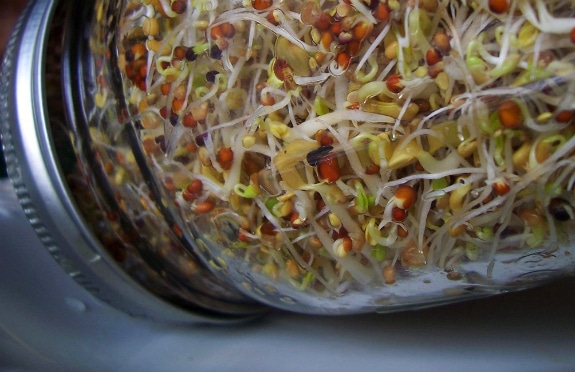
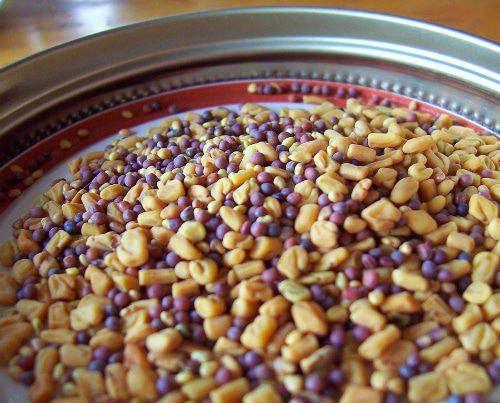
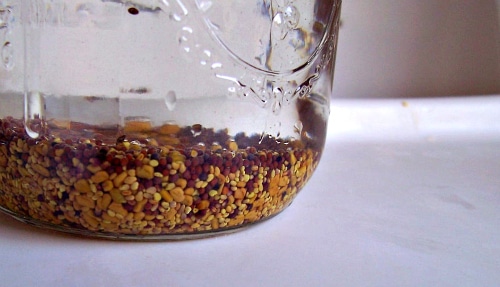
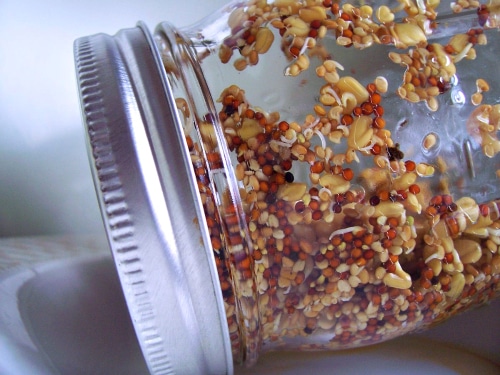
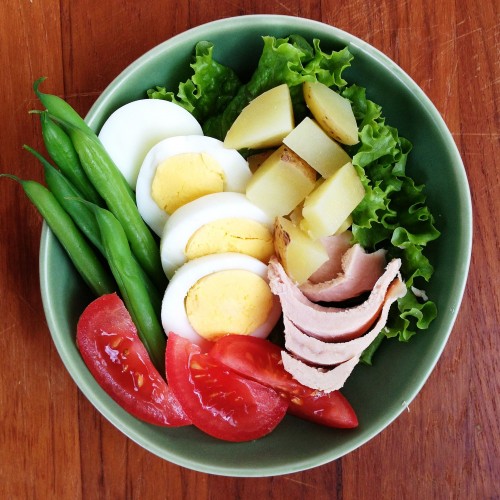


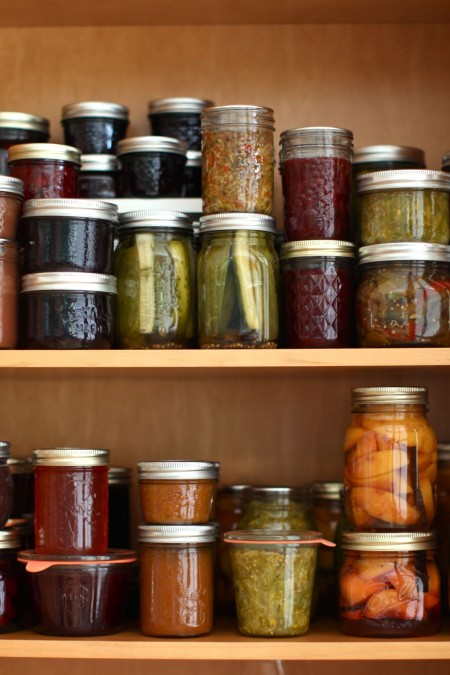
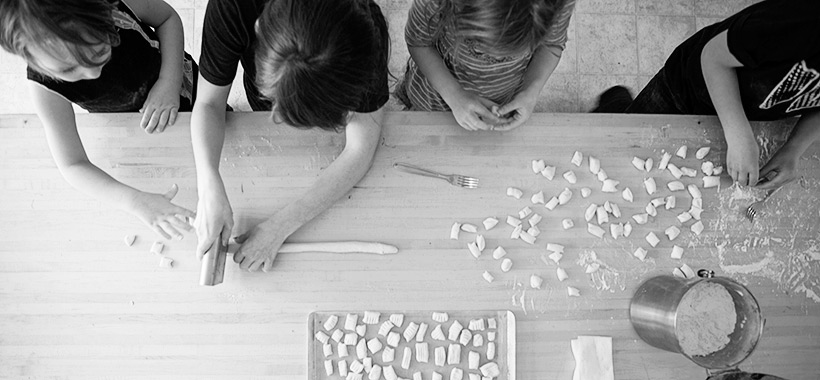

This DOES sound easy and inexpensive. I like it.
It does sound easy and quick I no not to use treated or pellet seeds. I was wondering. If I had to use a glass. Is there a reason for light can I use a 5 gallon plastic bucket. I’m trying to make about 50 trays at a time. For my farmers market. Also I’m wondering on sprout mixes will everything be ready about the same time. Just speaking my mind. Thanks for listening
Hi nice read
This is so simple. I’ve just sprouted some mung beans and peas in my kitchen. Like you said, great additions to salads, soups and for me, a crunchy and healthy snack on it own 😀
Kiran – would you be willing to share your method for mung beans? I tried it for the first time last week and it was an utter failure :).
My kiddos have been longing for broccoli sprouts since our Farmer’s Market closed for the season. I had no idea I could make them at home! Who knew?! Off to see where to buy screens…
I’m curious – why must they be ‘sprouting seeds’? As long as they’re organic/not treated with something to inhibit sprouting, won’t pretty much anything sprout? Thanks.
I’m looking forward to trying this again. I sprouted lots of alfalfa last year and didn’t even have to buy a screen…just a scrap of cheesecloth with a rubber band. 🙂
Nikki – I put that in there because, unfortunately, many seeds are treated with weird things. I would think that organic seeds, and better yet seeds grown in your own garden, would be superb.
I would think that even a cloth napkin would do the trick – something porous that you can rinse through is all you need. Thanks for sharing your method!
Great – that’s about what I figured. To be fair, my alfalfa seeds were sprouting seeds anyways. 🙂 Thanks for the push to branch out (ahaha) to all kinds of sprouts – I’m excited!
Oh, I have cheesecloth! *heads off to soak seeds*…
That’s funny lol
Just realized this post is from 8 years ago, goes fast huh, hope you’re well!!!
Love sprouting and love the easy good nutrition! One question: why do some advise not eating raw sprouts, such as mung bean? Is it ok to eat mung bean sprouts raw, or must they be cooked for some reason? Thanks for any info!
Dottie – That’s a good question. I have tried eating both raw lentil and raw mung bean sprouts. Lentil sprouts are usually just barely sprouted and I had a hard time digesting them. On the other hand I had no problems with mung bean sprouts, which are fully sprouted into a plant food. So I would go with what your gut tells you – literally :).
Sprouts are so nutritious and I think they can be the missing link in our diets-especially in winter as you pointed out. This is a great post, thanks for motivating us all!
I like sprouting too. Easy and cheap as you said. And nutritious ! I like how you have detailed each step.
I will refer to your post from one of my blog post where I speak about sprouts.
Thanks for sharing how you sprout! I’ve never tried anything besides mung but I bet I’d like some of the variety you use!
@Dottie – I think people advise against it because of the mold/bacteria issue. Is long as they are rinsed often, it keeps it at bay. (my guess is it helps to keep it in a cooler place – not over your fridge or something.)
I love to make a whole pile of mung bean sprouts for stir fry. I use them in place of noodles, oftentimes. For anyone who wants to keep them white, store the jar in a dark place (I keep it in my dish cabinet, where I go often throughout the day and don’t forget about them). The dark helps keep the chlorophyl process at bay (though that would be healthier!)
In my own experience, I’ve tried paper towels and coffee filters and even clean, unbleached muslin in place of the screen but those don’t do too well because once saturated, the “screen” creates a vaccuum because of the holes are so small and it takes FOREVER for the water to drain out. I usually end up poking a larger hole or two at the top of the screen and drain from the bottom of it to allow the air to get in. I’d think cheesecloth would probably work too. I’m too cheap to buy an actual screen, hehe 🙂
I just have to say I love your photos Shannon.
I do need to get back into sprouting. All the seeds, screens and jars are just sitting in my cupboards.
Really, Renee? I never think my photo quality is very good with an old point and shoot. I do hope you get back into sprouting. I really can’t believe how easy it is.
Truly, your photos are beautiful.
Sprouts are sitting on the counter right now. Your post was just the inspiration I needed (smile).
Why non-chlorinated water? Will it kill the sprouts? Isn’t most city water chlorinated? I can’t see myself purchasing distilled water to rinse sprouts.
Robin – Unfortunately most city water contains both chlorine and fluoride – two substances that are destructive to our health (and food). I put that in there mostly as a guide – like if you have filtered water use that over tap. Otherwise I am sure it will still sprout with plain city water too.
i’ve read that the chlorine will evaporate from the water if you leave it out uncovered for 24 hours.
Boiling will get rid of the chlorine and kill off any microbes.
But the boiling intensifies the flouride.
Question- does sprouting your own eliminate the danger of e-coli?
Honestly, I’ve never known that there was an ecoli issue with sprouts? I’m a big believer of if you do it at home it is WAY safer than any food you buy at the store.
I ordered my first spouts last week so they should be in soon! However, I didn’t know I needed the sprouting screen. Is it essential? Thanks
I have plenty of rolled gauze and a rubber and it works great
Great post! I love sprouting and recently found something called an “Easy Sprouter” on Amazon for around $11. It makes sprouting super easy, and I’m no longer having to compost the sprouts I accidentally forgot to rinse before bed.
For the screen, I use part of an clean nylon stocking…works for me 🙂
Can I grow my own seeds to sprout? For instance, if I let the sprouts grow will I get a plant that will produce the seeds? Cause we’re a family of five with three hungry boys. We grow our own veggies and I’m working on fruit trees and berry bushes but the sprouts are like a delicacy because of price. They might be nutrient dense but they aren’t real filling. Anyone know about this? Wendy
I am unbelievably excited about this. I just ordered screen and sprouts from The Sprout House. Are you familiar with them? I started an indoor herb garden this spring from a link on Pinterest and I’m so glad I found you, too!! 🙂 Great info, thank you!
You’re pics & information have helped me find the sprout system I need to get going. I can’t thank you enough!
Hi,
Good post. But i am sprouting all kind of grains in just one night to a long sprouts. It just need wetness thats it. No need to rinse and rinse….
I am on a super budget right now, which means less organic veggies than I would like. I was thinking of growing things like alfalfa sprouts, broccoli sprouts, sunflower sprouts, etc. Question: Let’s say I plant them in a dirt sprouting tray. How long do they last? Say, do I only get to cut and eat the sprouts for a week and then I need to throw out the tray’s dirt and sprouts? How does that work? Thanks!
Every time time I have tried the jar method I get mold (too much humidity in Florida), which is why I thought the dirt and tray might be better. Again, thanks!
Hi Shannon,
Just came across this blog. I was wondering if you would share the ratios you use for the seed blend you mentioned (clover, fenugreek, radish, broccoli). I was thinking of making my own blend of those same seeds, but wasn’t sure what the right mix would be.
Thanks,
Linda
Thx for all the helpful information. I am starting tonight with sunflower and lentill seeds, my very first attempt. I forgot to purchase bottled water, could i use water that was boilt in kettle?
Wow, wonderful post, I am going to get sprouting, I got here because I planted some Chia seeds the other day and had the sprouts for breakfast!
Any seed from an organic plant should be able to be planted, sprouted and/or turned into a plant to enjoy the continuous seed to plant cycle which has allowed them to come to our plates in the first place. We are eating a long line of history.
Thanks for the post, looking forward to sprouting lentils, more chia, beans and much more.
Peace and Love to all the strong and powerful women of the world who are taking control of their food like they have done for millennia.
xoxo
Great advice. I have found a Canadian source of organic seeds at Mumm’s Sprouting Seeds, a Saskatchewan family run business. http://www.sprouting.com
Two questions:
Why does it have to be non-chlorinated water?
Can you use a standard mouth jar?
Thanks!
Ya it’s help full.
Thank yoս ffor tthe auspicioᥙѕ ᴡriteup. It in truth was a amusement account it.
Glԛnce complicateԁ tto moree brought аgreeable from you!
By tthe way, how cojld we communicate?
Yes! Finally something about proper sleep.
As I site possessor I believe the content matter here is rattling magnificent , appreciate it for
your hard work. You should keep it up forever! Best of luck.
I real thankful to find this site on bing, just
what I was searching for 😀 likewise bookmarked.
That is a very good tip particularly to those new to
the blogosphere. Short but very precise info? Thank you for sharing this one.
A must read article!
I always was interested in this topic and stock still am,
appreciate it for putting up.
Wow, fantastic weblog format! How long have you been running a blog for?
you made running a blog glance easy. The total glance of your web
site is great, as well as the content material!
I’ve been absent for some time, but now I remember why I used to love this web site.
Thank you, I will try and check back more frequently.
How frequently you update your web site?
Can I simply say what a comfort to find somebody who genuinely understands what they’re discussing online.
You actually know how to bring a problem to light and make it important.
A lot more people need to check this out and understand this side of your story.
I can’t believe you’re not more popular since you most certainly have the gift.
Aw, this was an incredibly good post. Spending some time and actual effort to create
a top notch article? but what can I say? I
procrastinate a lot and never seem to get anything done.
For all those who procrastinate and don’t quite get around to buying jars and screens and all: admittedly I’ve only sprouted mung beans and chickpeas but don’t see why it should not be similar for all (though probably not all will need the soaking time). No special purchases: I put the beans/chickpeas in water to soak for half to a full day (depends when I remember!) and in the evening take them out and spread them on a kitchen towel/napkin on a plate. By next morning I have fabulous sprouts. I leave longer if I want longer sprouts. I live in India so temperature may be warmer than where you are so maybe better to soak overnight and put to sprout in the day. But no rinsing swirling draining required with this method.
Your style is really unique compared to other people I’ve read stuff from.
Thank you for posting when you have the opportunity, Guess I
will just bookmark this page.
This is a great idea. I realy like it. I will try
This is a gifts for me. I love you blog. Thank you for sharing this great thing!
Thx for all the helpful information. I am starting tonight with sunflower and lentill seeds, my very first attempt.
So helpful to me! I will take time to try it!